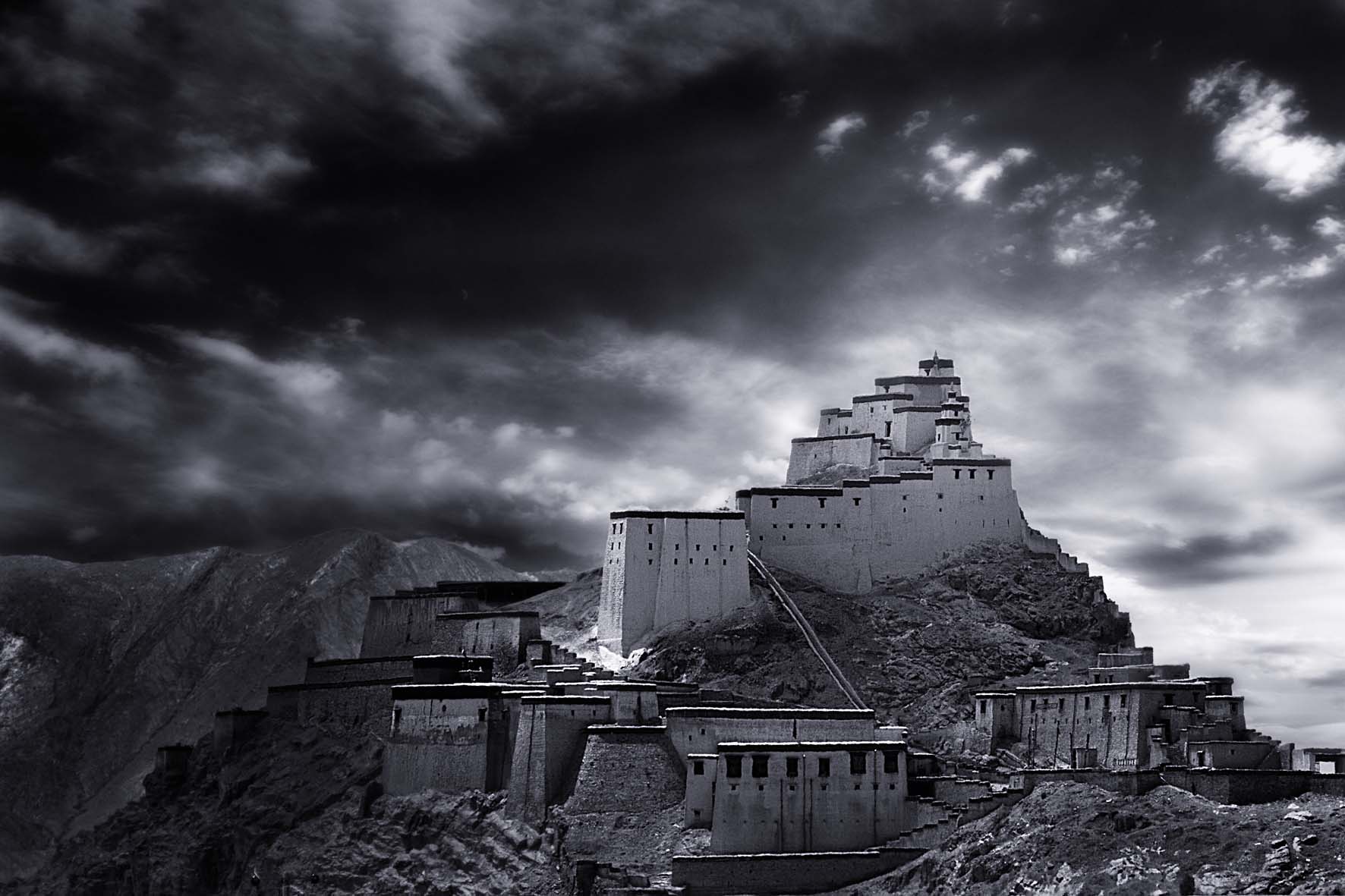
Close to Gyantse fort in Tibet, at the Palkhor Chode Monastery, an old Chinese man approached me with curiosity. I reciprocated with a smile to help break the ice.
Old Chinese Man : “You are wearing a turban. Are you a Sikh?”
Me : “Indeed and I am surprised you are able to recognize a Sikh in this remote part of the world.”
Old Chinese Man : “Sikhs are no strangers to this region. In the past they have led many military expeditions on the Tibetan plateau with reasonable success.”
Me : “Yes indeed. I am aware that in the year 1841, under the leadership of Maharajah Ranjit Singh of Punjab, General Zorawar Singh’s forces came deep in Western Tibet. Having started the Ladakh (small Tibet) campaign in 1834, after Ranjit Singh’s death in 1839, the forces continued deeper into Tibetan plateau. I also know that at Taklakot in Tibet, there exists a Chorten (memorial) of General Zorawar Singh.”
Old Chinese Man : “You do know that history of year 1841 expedition of the Sikh kingdom into Tibet. Well the Sikhs entered again, but this time with British, in the year 1904.”
I had only heard about General Zorawar Singh’s expedition to Tibet in 1841 but what was the Chinese man’s reference to the entry in 1904? This conversation created a spark of curiosity, leading me to research the following three old books to gain better insight into Lietunant Younghusband’s expedition to Tibet in 1904 with the 23 and 32 Sikh Pioneer regiments.
1) With Mounted Infantry inTibet by Major Ottley
2) India and Tibet by Sir Francis Younghusband
3) Waziristan to Tibet by Cyril Lucas
In early 1900′s the “Great Game” being played in Asia had resulted in expansion of British across India, under the banner of East India Company. In the North of Asia, Czars of Russia were becoming ambitious to expand their reach into the Pamir mountain ranges, getting them closer to India. British secret services were getting an indication of an alliance being forged between the Tibetans and the Russians. There were reports of European breeds of dogs spotted on the Tibetan plateaus, which could have only come on land through Russia. Should the Russian reach extend into the Himalayan plateau, it would be too dangerous for British India.It meant the political war between British, French and Russians that was being engaged in Europe could be fought on the grounds of India.
In light of this development, the British had to nullify the potential Russian advance into Tibet.
Lietunant Colonel Sir Francis Edward Younghusband, with regiments of 23 Sikh Pioneers and 32 Sikh Pioneers, entered Tibet from Sikkim in the year 1904. They were successful in conquering the Gyantse Fort (which was built around 12th century) and made it their base from where they led further successful expeditions to Karo La pass (5,010 meter) and Lhasa. These may sound just names but having personally traveled to the heights around Karo La pass, due to thinness of air, I found it hard to carry my two heavy cameras. One can only imagine the feat for the soldiers at these heights, having to carry their weapons and backpacks.
The success of this expedition resulted in a treaty between British India and Tibet, resulting in the weakening the Russian aspiration of expansion. Thereafter the British Indian forces subsequently moved back from the Tibetan plateau.
Along the way from Lhasa to Gyantse, one can still find remains of stone fortifications built by 23 and 32 Sikh Pioneer regiments as they advanced on the plateau. I spotted many of these bricked outposts while driving from Lhasa to the Western front of Tibet.
History quotes Hannibal’s crossing of the Alps, in 218 BC, to invade imperial Rome as one of the most celebrated achievement of any military force in the ancient warfare. The Alps are pygmies in comparison to the advances that had to be made from the plains of India to Tibetan plateau, crossing the formidable Himalayas. Only soldiers with a selfless grit could have achieved this feat in a short time frame, returning back to the plains of India safely. They just had to make a point that the plains of India will not entertain any move for European wars to be bought to the sub-continent.
Let me share the pictures that I took of Gyantse Fort in Tibet and very old sketches of Sikh soldiers in action on the Tibetan plateau. These sketches featured in LIFE magazine in early 1900’s. I stumbled on them as I embarked to satisfy the curiosity that developed after the discussion with the Chinese man at Gyantse Fort.
 Gyantse Fort (Photo by Amardeep Singh – July 2012)
Gyantse Fort (Photo by Amardeep Singh – July 2012)
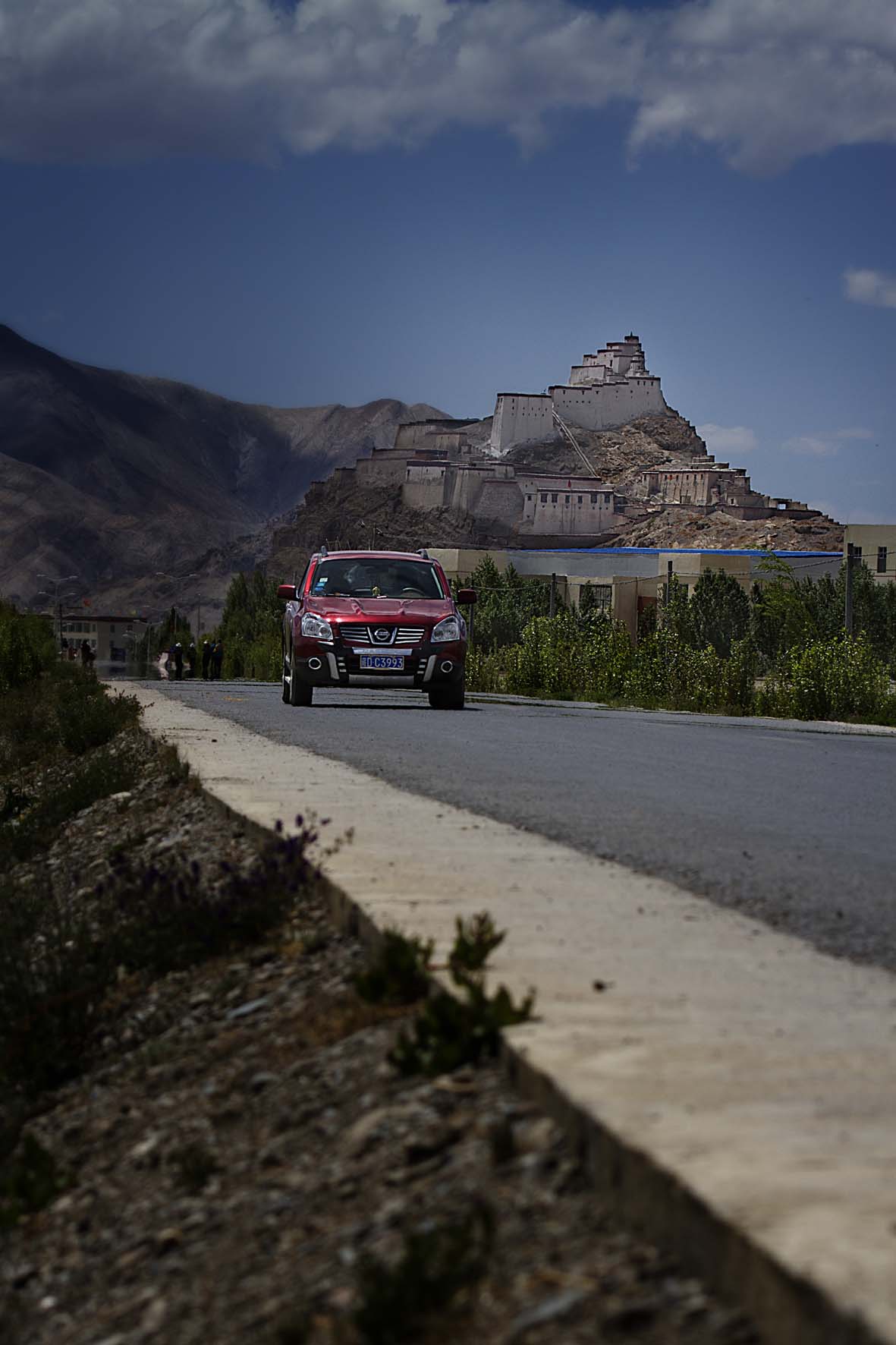
Gyantse Fort (Photo by Amardeep Singh – July 2012)
Sketches of Lietunant Colonel Sir Francis Edward Younghusband’s Tibet expedition with 23 Sikh Pioneers and 32 Sikh Pioneers.
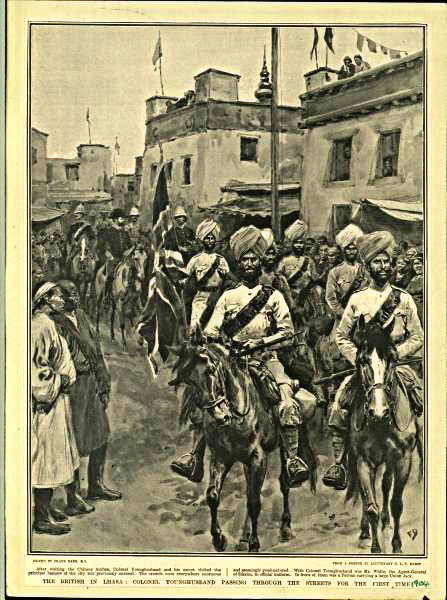
Sikh soldiers march through Lhasa.
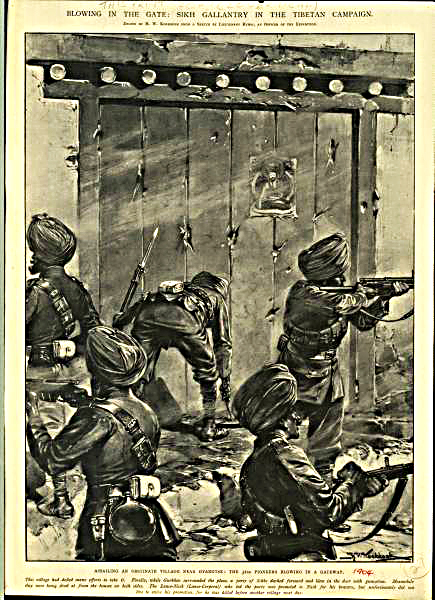
Sikh soldiers in action at Gyantse Fort.
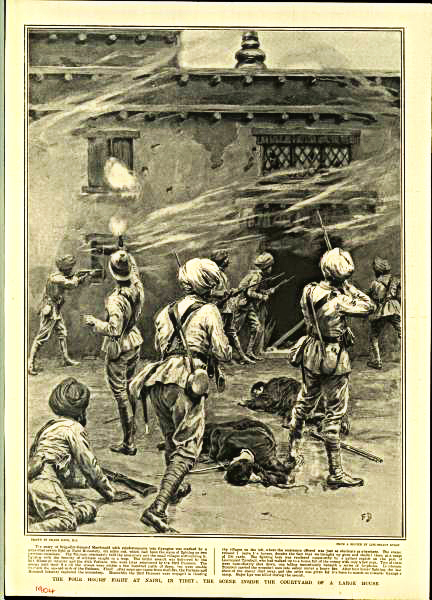
Sikh soldiers in action at Gyantse Fort.
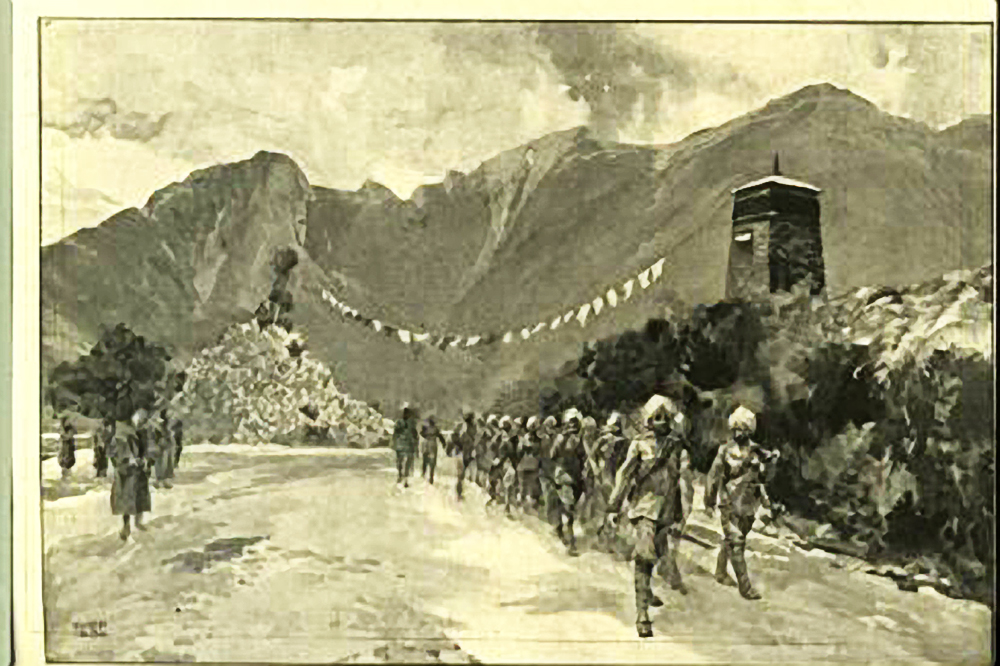
Sikh soldiers marching on Tibetan plateau.
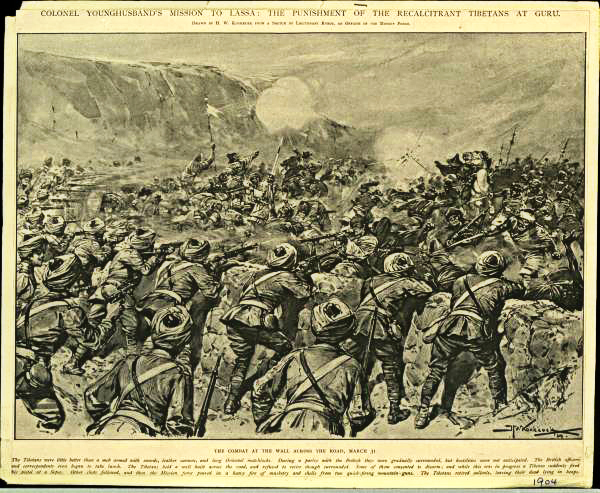
Col Younghusband’s forces in action at Guru in Tibet.
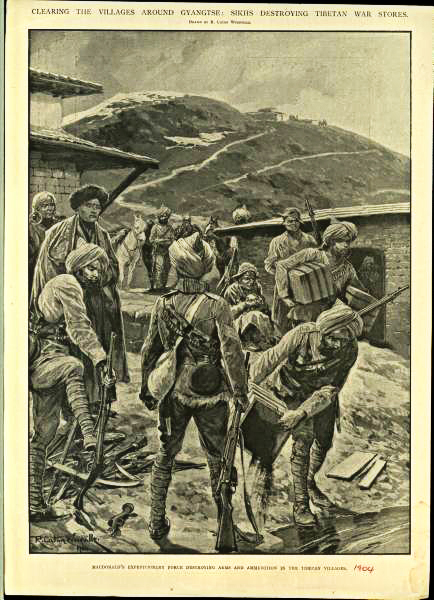
Sikh soldiers clearing ammunition at Gyantze Fort after its occupation.
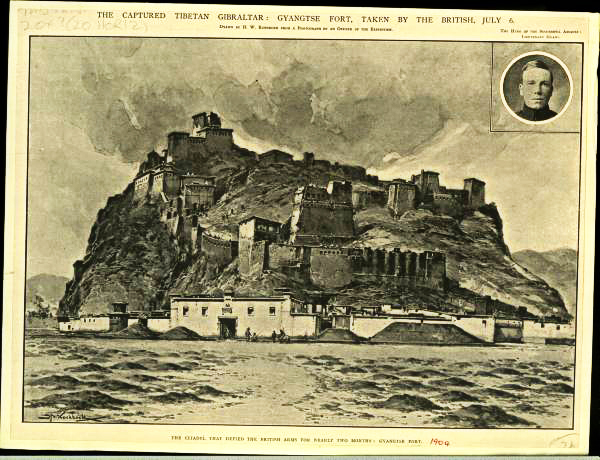
Gyantse Fort after its capture. Plate dated July 6, 1904.
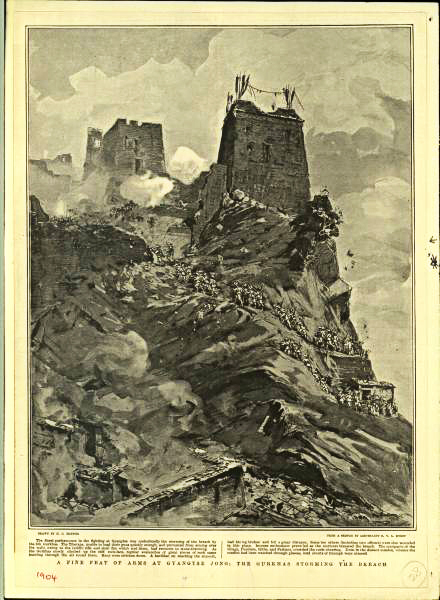
Soldiers in action during their attack on Gyantse Fort.
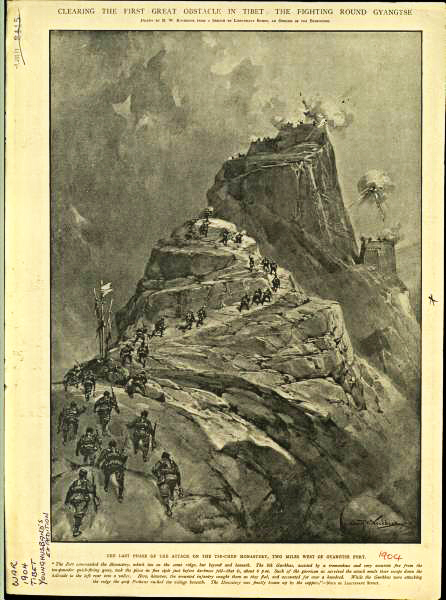
Soldiers in action during their attack on Gyantse Fort.
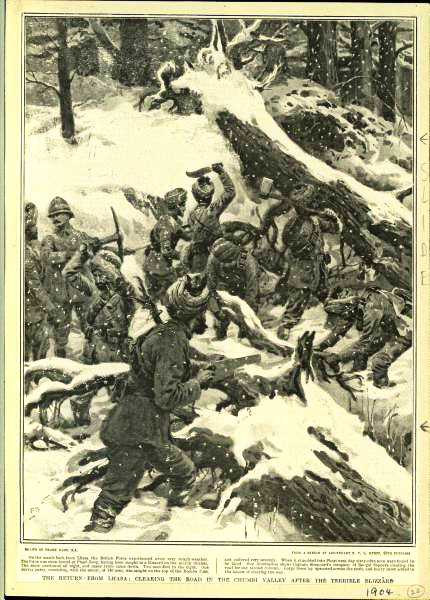
Sikh soldiers clearing their way in thick snow, during the march to Gyantse fort.
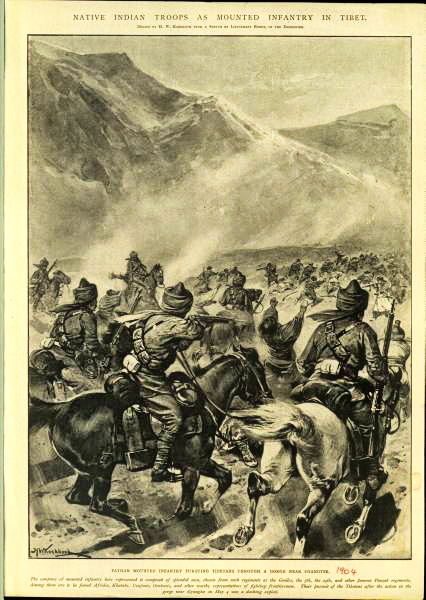
Indian mounted Infantry on the Tibetan plateau.
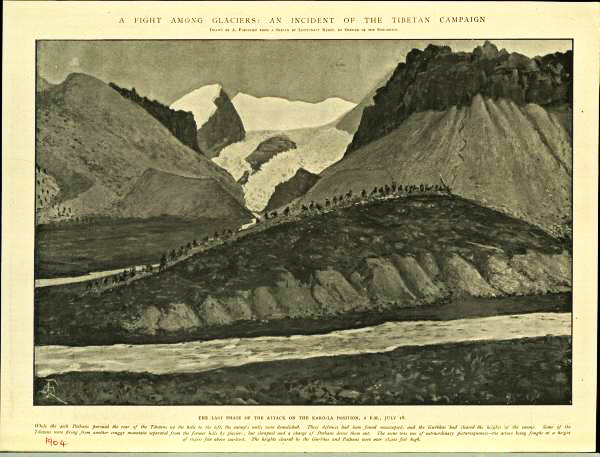
A battle fought on the Glaciers of the Tibetan plateau.
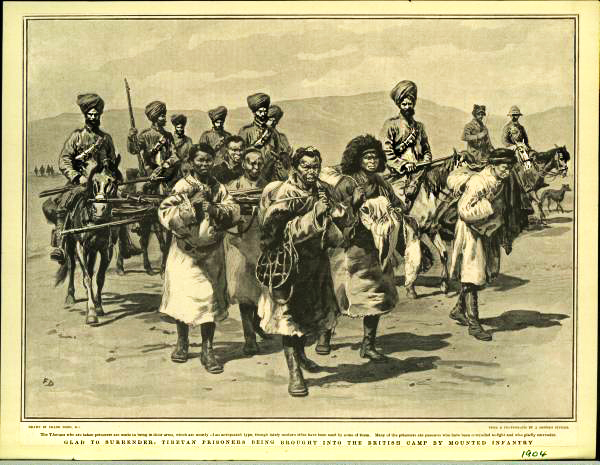
Surrendered Tibetan soldiers being escorted to the camp.

Comments(55)
mintisingh says:
January 2, 2013 at 7:35 PMSuperb information. Carry on d great work.
So proud of u. Be Blessed.
Satinder Rekhi says:
January 2, 2013 at 10:26 PMVery interesting,
Dhiraj says:
January 3, 2013 at 2:22 AMImpressive Sardars! Fabulous information and great narration Amardeep.
Devinder Jit Singh says:
September 3, 2020 at 9:45 PMFantastic ! Never knew that Sikh soldiers had accompanied the Younghusband exp. I wonder if you could get hold of the regimental diaries.
Jasmeet says:
January 3, 2013 at 8:55 AMVery informative. Looking forward to the pics from this series!
Aarti Sreenivas says:
January 3, 2013 at 9:59 AMLoved the conversation between you and the Chinese man! The Black and white picture looks very dynamic. Almost as though the clouds are moving and the photo is more like a video capturing that movement. Lovely shot!
Ajeet Singh Mac says:
January 3, 2013 at 1:36 PMDear Amardeep Singh Jee……GURU FATEH …You are doing a great job in exploring sikhs history prior to take over by Britishers of India . I suggest that The Vice Chancellors of Universities should act under your guidance to do PHd in this important field of knowing history of Sikh Generals of Indian Army during 1947,62, 65 & 71 wars. These jokers are sitting on these chairs , which should be the right of KHALSAS like you which will prove to be great use for coming generations . Any help required on this issue can be availed with my top notch contacts & support of retired Generals . Kindly tell SGPC/SAD leasrship to think on these vital issues using modern tech advances etc…… With GOD’S LOVE
Jashan says:
August 25, 2019 at 12:39 AMVery nice piece of information
Dil Bahra says:
January 5, 2013 at 7:47 PMAmardeep. Very interesting indeed.The family of a British Officer who wasw on the Younghusband Expedition contacted me a couple of years ago and provided me with a photo of Sikh Soldiers and Army Officers playing Hockey during the expedition in 1904. The photo is on my web site (www.sikhhockeyolympians.com) under India page (first photo).
PAVANDEEP SINGH says:
January 8, 2013 at 8:57 PMSHAN OF SINGHS. GOOD POSITIVE WORK ON THE GLORY OF SINGH KHALSA
DAVE mANN says:
January 10, 2013 at 9:05 AMi AM AWARE LITTLE ABOUT THAT SIKHS CONQUERED KASHMIR AND PARTS OF TIBET ANS ANNEXED THE STATE OF KASHMIR FROM AFGANISTAN+ LEH FROM TIBET. AT LAST EXPEDITION UNDER MAHARAJA RANJIT SINGH.EXPEDITION WAS FAILURE FOR ALL THE SIKH SOLDIERS ARE EITHER KILLED OR WHO SURRENDERED WERE BEHEADED
Amardeep Singh says:
January 10, 2013 at 10:07 PMDave Mann, This write up is not about the 1841 campaign under Maharaja Ranjit Singh. It is about the 1904 expedition under “The Great Game”.
The 1841 campaign went across Baltistan, Ladakh and then went deep into Tibet, reaching Mount Kailash, Mansarovar. The last battle was at Purang, where the leader, Zorawar Singh died on the battlefield.
“Tibet : A Political History” by Tsepon W.D. Shakabpa, who was Dalai Lamas Finance Minister for Tibet says the following about the Sikh soldiers after they army fell deep inside Tibet at Purang in the 1841 expedition.
“….Those prisoners wishing to return to their own country would be allowed to do so…….One third of the Sikh and Ladakhi prisoners elected to remain in Tibet. The Sikhs were resettled in the warmer regions of Southern Tibet by the government and many of them married Tibetan girls. The Sikhs are known to have introduced the cultivation of apricots, apples, grapes and peaches into the country.”
The failure or success of the 1841 expedition needs to be viewed from the perspective that Ladakh exists on the map of India because of this expedition which added it to the Sikh Kingdom, which fell into the British Empire after the second Anglo-Sikh war.
adarsh says:
January 11, 2013 at 6:37 PMAmazing piece of information, infact its learning time for me, never knew any of it…..as always ur work is not just creative its got depth n information..salutations!!
INDERJIT SINGH GILL says:
March 25, 2013 at 3:27 PMS Amardeep Singh ji, Sat Sri Akal. A great work and congrats for it. Prayers to Guru to bless you for keeping it going. Part I made very interesting reading. I am yet to visit Part II. My interest is to know about that 1/3 rd, who stayed put there. I am sure you would have visited that area also!! Can you throw some light on that as well?!! Congrats once again and keep it going.. God bless.
Rajinder Singh says:
March 25, 2013 at 4:37 PMDear Amardeep ……WAHEGURU JI KA KHALSA WAHEGURU JI KA FATEH …You are doing a great service in exploring our history prior to Independence of India. I suggest that The Vice Chancellors of Universities and respective chairs should take the research project for the student in this important subject: history of Sikh Generals of Indian Army and their contribution to the country post Independence and before. Paramjeet, Manav join me and Congratulate you for your great work for the community at large, which will prove to be great use for coming generations . Any assistant required from my side feel free to contact. Thanks for using modern tech to share vital information at large.
May Waheguru bless you and your family,
Rajinder Singh, Paramjeet and Manav.
Rajinder Singh Bhasin says:
March 25, 2013 at 4:54 PMDear Amardeep ……WAHEGURU JI KA KHALSA WAHEGURU JI KA FATEH …You are doing a great service in exploring our history prior to Independence of India. I suggest that The Vice Chancellors of Universities and respective chairs should take the research project for the student in this important subject: history of Sikh Generals of Indian Army and their contribution to the country post Independence and before. Paramjeet, Manav join me and Congratulate you for your great work for the community at large, which will prove to be great use for coming generations . Any assistant required from my side feel free to contact. Thanks for using modern tech to share vital information at large.
May Waheguru bless you and your family,
Rajinder Singh, Paramjeet and Manav.
SARABJIT SINGH SAWHNEY says:
June 25, 2013 at 1:12 AMThis article and detail are very interested are there any sikhs leaving in tibet as i see on the other articles Hindus are playing to color this as the hindu dongra victory .
Amardeep Singh says:
June 25, 2013 at 7:54 AMPlease note that this write up is not about the 1841 campaign under Maharaja Ranjit Singh. It is about the 1904 expedition under “The Great Game”.
The 1841 campaign went across Baltistan, Ladakh and then went deep into Tibet, reaching Mount Kailash, Mansarovar. The last battle was at Purang, where the leader, Zorawar Singh died on the battlefield.
“Tibet : A Political History” by Tsepon W.D. Shakabpa, who was Dalai Lamas Finance Minister for Tibet says the following about the Sikh soldiers after they army fell deep inside Tibet at Purang in the 1841 expedition.
“….Those prisoners wishing to return to their own country would be allowed to do so…….One third of the Sikh and Ladakhi prisoners elected to remain in Tibet. The Sikhs were resettled in the warmer regions of Southern Tibet by the government and many of them married Tibetan girls. The Sikhs are known to have introduced the cultivation of apricots, apples, grapes and peaches into the country.”
The failure or success of the 1841 expedition needs to be viewed from the perspective that Ladakh exists on the map of India because of this expedition which added it to the Sikh Kingdom, which fell into the British Empire after the second Anglo-Sikh war.
It doesn’t matter what was the religious belief system of Zorawar Singh. What is important is that Zorawar Singh was a paid employee of Maharaja Ranjit Singh’s empire. The Dogra kings of Jammu & Kashmir were under Maharajah Ranjit Singh, and through their extended presence in the region, Ranjit Singh approved the armys advance into Ladakh, Baltistan and Tibet.
Capt NSSahni says:
August 24, 2019 at 1:04 AMThere is old fort in Baltistan, still existing, as mentioned by BBC ‘s Micheal Pallien, which is was OCCUPIED BY SIKHS, DURING ENGLISH OCCUPATION, –this is the place where PAKISTANI S, ARE NOW INCREASINGLY settling, and marrying The Hunza girls, to change the demography,
vijay crishna says:
September 12, 2013 at 2:46 PMVery nice pictures! This expedition has been long-forgotten, but was important for several reasons – not least among them being how the British Empire imposed its will on neighbouring kingdoms using native Indian troops (Sikhs and Gurkhas) as their main attack forces. Interstingly, your picture no 7 is not from this campaign at all – but features Sir Aurel Stein on one of his expeditions to Dunhuang (he’s easily recognisable because his terrier dog Dash is by his side!).
Karamjeet Singh says:
September 25, 2013 at 7:38 PMThanks for posting the history information of the British Expedition to Tibet 1904 and that the Sikh forces enteredTibet for the second time.Your picture of the formidable Gyantse fort is beautiful.Since the topic is Sikhs forays into these lands,I will share another important event that Sikhs resolved at Peking(Beijing)China.During the Boxer Revolution 1901-02,Sikh contingent deployed from Calcutta,rescued the embassy staff of all countries holed up in diplomatic quarters.Sikhs entered through the sewer and climbed the inner walls and defeated the Boxers in a Hand to hand fight.This event is covered by the book ‘Seige of Peking’ with few sketches.I had posted these sketches in FB and the book is available in the Libraries.Sikhs’ contribution to military history is coming to attention now but given only passing references.Thanks again!
Col. Harindar Singh Bedi says:
September 26, 2013 at 9:48 PMThis is another very interesting saga of Sikh foray into Tibet, albeit as part of a British force this time. Would be interested in reading more of your travelogues.
RS RAJPUT says:
December 4, 2013 at 9:02 AMSikh valour is exemplary and eternal. No wonder Pandit NEHRU was so keen to ensure the liquidation of HALF THE SIKH COMMUNITY on one day vide his Act of Unconditional Surrender of 1947, called “PARTITION” OF INDIA. He must have feared that the freedom and democracy loving Sikhs would undo his treacherous plan to keep India as his SLAVE COLONY for generations to come.
His daughter, Indira Gandhi (MAIMOONA BEGUM after her secret nikah with Feroze KHAN of Allahabad, tried again to DECIMATE the Sikhs in 1984 with her brutal attack on Golden Temple in Amritsar when huge congregations had gathered for an important religious occasion. Her son Rajiv succeeded her effortlessly, and now his widow SONIA GANDHI is the virtual ruler of Hindusthan with RAHUL Gandhi waiting to become the next Prime Minister.
Repression of Sikhs will continue while the HINDU nation is least perturbed whether the rulers are Turks, Afghans, Persians, French, British, or now the ruling NEHRU DYNASTY.
For research into the fighting ability and valour of Sikhs one cannot expect even two pence as support or encouragement from India.
So CONGRATULATIONS for the dedication and commitment to complete your historic Project that could be taken up by some Western universities.
Salman Rashid says:
April 12, 2014 at 9:40 PMGreat job, Amardeep. You are a treasure I discovered a little too late.
Thank you so very much.
Jasbir MAKAR says:
June 24, 2015 at 6:36 PMa splendid piece of rich history of the great warriors Sikhs !!!
Rajinder Singh Gulati says:
June 24, 2015 at 9:29 PMVery informative article on sikh history beautiful pictures please keep posting god bless you
Ashmeet Sidhu says:
June 24, 2015 at 9:40 PMSuper article. Thks for sharing Amardeep.
Gurvinder Gumani says:
June 25, 2015 at 7:55 AMWonderful article. Very informative. Just incredible. You are a genius. A blessed soul indeed. Lots of love.
Bijaya Jena says:
June 25, 2015 at 8:00 AMThanks a lot for this rare info.
Ravinder Singh Sandhu says:
June 25, 2015 at 8:00 AMVery interesting and informative…quite an insight.. good job Amardeep !!
Anju Bhasin says:
June 25, 2015 at 8:01 AMVery interesting read.
Upinder Kaur says:
June 25, 2015 at 12:46 PMGreat! A nice informative article. Thanks for sharing this knowledge.
Surupa Chatterjee says:
June 25, 2015 at 2:25 PMAn intriguing and unknown bit of history wonderfully expressed through a master storyteller and a gifted visualizer as yourself….each post of yours is very much like stepping into an unknown land . Thank you.
Manjit Kour says:
June 25, 2015 at 11:01 PMYet another amazing piece. I am learning so much through you. I look forward to your postings each time. Thank you.
Ajay Tripathi says:
June 26, 2015 at 11:03 AMA very interesting historical information with extensive research behind it. Never knew about this. Tks for reproducing the sketches of Francis Edward which actually takes the viewer back to 1904. The first photo (in B&W) of the fort is marvelous.
Geetali says:
June 26, 2015 at 3:14 PMThank you once more for a great write-up. It was most informative. I have long been fascinated by the career of Francis Younghusband and your latest post adds to my knowledge about this strange and intriguing man.
As always, your photos are outstanding.
mustafa says:
June 28, 2015 at 2:21 AMThe people you meet,
The corners you find,
The facts you chase,
Far out.
Far Far out.
kishore kumar biswas says:
June 29, 2015 at 1:47 AMAnother amazing pictorial note on History of this subcontinent. The story of bravery and gallantry. It tells us the great tradition of courage and loyalty of an unique ethnic group.It speaks that Sikhs are a heroic race. Indomitable spirit they are.
Regards to Amardeep who untiringly enlightens us about the History of our country .
tEre-tErRiTOrY » 跑遊元朗八鄉 (16) - 八鄉古廟及擎天一柱回歸紀念 says:
July 1, 2015 at 11:38 PM[…] ↑ 1904年西藏江孜保衛戰﹕藏軍用落後裝備血戰英軍,用來幻想當年新界六日戰爭中石頭圍戰事一幕(照片源自 Sikh soldiers in Tibet – Year 1904 | Amardeep Photography ) […]
LAL SINGH says:
July 5, 2015 at 11:00 PMVery Informative.
Congratulations to Amardeep to bring to light our forgotten history.
tEre-tErRiTOrY » 跑遊元朗屏山鄉 (29) - 絳華別墅與香翰屏將軍 says:
July 6, 2015 at 11:47 PM[…] Sikh soldiers in Tibet – Year 1904 | Amardeep Photography […]
ashok lp mendonca says:
September 8, 2015 at 1:38 AMam really proud to see methodical approach to the photodocumentaion….our country’s weak point! keep up the good work!
Arjun says:
June 13, 2016 at 11:17 AMDear Amardeep,
Very interesting write up. Wanted to check with you if you have the original photos/ prints of the pictures. We would love to display the prints in our army mess. Please do revert to us at 9465824123
raj says:
July 5, 2017 at 2:39 PMEXCELLENT NO WORDS
raj says:
July 5, 2017 at 2:39 PM1
isher says:
April 4, 2018 at 6:27 AMThank you Amardeep.
Joginder Singh says:
August 18, 2019 at 1:50 AMA very hazardous task undertaken and very commendably carried out. We are proud of you and all the information that you are collecting. Hope you found adequate evidence of Guru Nanak Dev ji’s visit to Tibet?
SATPAL SINGH says:
August 24, 2019 at 11:39 AMVery informative
Balbir Singh Sohal says:
August 24, 2019 at 3:56 PMHidden treasure of Sikhs achievement by the grace of God under the leadership of able leaders in war and peace. Remarkable. Some thing proud to be of. Wow unbelievable.
Inderjeet Singh Basra says:
August 26, 2019 at 2:05 AMDear Amardeepji
Amazing work. Your work will pave the way and encourage research on the forgotten Sikh history. I strongly believe that your honest efforts will put the present day Sikh leaders to shame as how they are conniving with RSS to ruin and undone the great culture. May God be with you.
BhupinderSingh says:
August 26, 2019 at 11:25 AMAlarming: this aspect of History is not circulated .
Appericiate the work and pictures which predict the outcome.
Devinder Jit Singh says:
September 3, 2020 at 9:46 PMFantastic ! Never knew that Sikh soldiers had accompanied the Younghusband exp. I wonder if you could get hold of the regimental diaries.
Kundan Singh Jangpangi says:
September 3, 2020 at 10:04 PMThanks for your illuminating post and rare photographs.
rom where can have the books mentioned in your blog. Will be grateful if you could respond pl.
Brig Sarbjit Singh says:
September 5, 2020 at 5:30 PMindeed great effort for researching thru .pre WW I contribution.. of Sikh soldiers.
we are very proud of contribution . of Sikh soldiers .of past present and future .
Rajpal Singh says:
September 6, 2020 at 2:55 AMAmardeep Singh Ji Sat Sri Akal. Truly admirable work to bring these historical facts to light. It strengthens my conviction that the Sikh soldier and the Sikh in general were not given recognition for being selfless and denied their due.